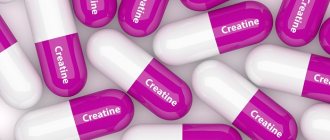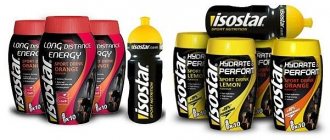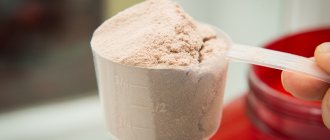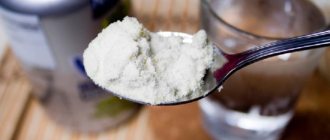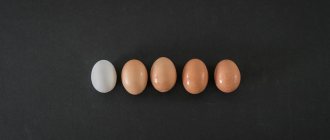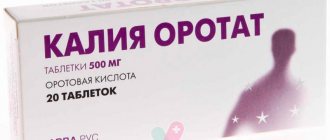© designer491 — depositphotos.com
Share:
Glycine is a proteinogenic amino acid used by the body to build proteins. This compound also acts as the basis for the formation of molecules of creatine, porphyrin, serotonin, and purine nucleotides in cells.
Preparations containing this amino acid are used in medicine as neurometabolic stimulants. In sports nutrition it is used more often as a food additive that modifies the taste and smell of the product, sometimes as a sedative component.
Amino acid glycine - role in the body
Glycine is a proteinogenic amino acid that is used by the body in building protein molecules. It also participates in the formation of creatine, porphyrin, serotonin, and purine nucleotides.
Glycine can be found not only from sports nutrition manufacturers, but also from pharmaceutical companies. Glycine is available for free sale in pharmacies, and its cost in a pharmacy is relatively low when compared with foreign companies producing dietary supplements.
In pharmacology, glycine is used as a sedative with antidepressant, sedative and tranquilizing effects. Glycine also helps improve memory and mental performance. Most often, glycine is produced containing vitamins B and D3 in the preparation.
You can take glycine for the following indications:
- Decreased mental performance.
- Stress and psycho-emotional overstrain.
- Increased irritability and excitability.
- Emotional instability.
- Traumatic brain injuries.
- Stroke.
- Alcoholism.
Research
Glycine was first isolated and described by the French chemist and pharmacist Henri Braconneau. The scientist obtained sweet crystals during experiments with gelatin in the 20s of the 19th century. It was only in 1987 that the cytoprotective properties of this amino acid were described. It has been found that it promotes the restoration of living cells after hypoxia. Experiments on animals have shown that this compound is used by the body to neutralize the effects of ischemia - a violation of the blood supply.
However, under conditions of severe stress, for example, during an ischemic stroke, glycine temporarily becomes a conditionally essential amino acid, that is, it cannot be synthesized by the body.
When administered externally, it perfectly protects cells from oxygen starvation. Presumably, glycine reduces the permeability of the cell membrane, thereby maintaining electrolyte balance and preventing the destruction of cellular structure.
Mostly Russian scientists are engaged in research into the properties of the amino acid; in the West it is recognized as ineffective and is practically not studied. The only use of the compound in the United States is as an irrigation solution for interventions performed by the transurethral route.
Russian scientists are more busy researching the nootropic, tranquilizer, antitoxic, and antidepressant properties of glycine. Some of them showed the effect of this compound in eliminating sleep disorders.
Glycine has also shown a neuroprotective effect: when taken in the first 3-6 hours after an ischemic stroke, the drug reduces the extent of its consequences. Russian scientists also came to the conclusion that the use of amino acids has a sedative effect as a nootropic.
Western colleagues do not share the point of view of Russian researchers, believing that all observed actions are due to the placebo effect. Indeed, it has still not been possible to substantiate the effectiveness of the drug using evidence-based medicine.
Why is glycine used in sports?
In sports nutrition supplements it is a taste and aroma enhancer and is listed as food additive E640 .
It is known that athletes need additional amino acid intake for training and preparation for competitions. However, the additional use of glycine as a separate component is necessary not only for high physical stress, but also for psycho-emotional stress. Overtraining, physical fatigue and the athlete’s anxiety cause some central nervous system disorders that glycine fights: it improves concentration, increases calmness and endurance, and also increases motivation. It is these qualities that an athlete needs in the pre-competition period, 2-4 weeks before the competition, and athletes adhere to this course of treatment.
Recommendations for correct use
The scheme for using “Glycine” in sports is simple and requires strict adherence. Exceeding therapeutic doses of the product will not give more pronounced results, but will only provoke negative consequences. In particular, amino acid abuse threatens rapid depletion of glucose reserves. The body will quickly use up this source of energy, which will lead to metabolic failure, lethargy, and fatigue. Also, systematically exceeding the permissible volumes of the composition is fraught with the accumulation of lactic acid in the tissues. Under the influence of physical overload, this condition can develop into a lactic acid coma, which threatens not only the health, but also the life of the athlete.
The benefits and harms of glycine
Benefits of glycine for the body:
- Increases mental performance.
- Reduces stress, tension and psycho-emotional fatigue.
- Has a sedative effect.
- Improves sleep and makes it easier to fall asleep.
- Improves brain function and restores its cells, including when drinking alcohol.
- Improves memory.
Disadvantages of glycine:
Of course, you need to take glycine only as directed ; you shouldn’t take it additionally on your own without a reason. In some cases, glycine can cause side effects, although the amino acid is considered harmless and its overdose has not been identified.
Effect on the body
Glycine is a neurotransmitter acid. In the brain and spinal cord, glycine sensory neurons are the most common inhibitory receptors.
By joining them, this amino acid reduces the release of excitatory substances from nerve cells and increases the release of gamma-aminobutyric acid, the most important inhibitory neurotransmitter of the central nervous system. Glycine also has an inhibitory effect on spinal cord neurons responsible for maintaining muscle tone and motor coordination.
Glycine has the following effects:
- reduction of emotional stress;
- reduction of aggressiveness;
- improving the ability to socially adapt;
- increased emotional tone;
- Facilitation of falling asleep, normalization of sleep;
- reducing the negative consequences of exposure to toxic substances on brain tissue (including ethanol, toxic compounds of medications);
- restoration of the structure and function of brain cells after injury, inflammation, and ischemia.
Glycine molecules are small, so they freely enter the tissues and fluids of the body and overcome the blood-brain barrier. In cells, the compound breaks down into water and carbon dioxide, which are easily excreted, so glycine does not accumulate in tissues.
© mikrostoker — depositphotos.com. Useful properties of glycine
What sports nutrition can it be combined with?
Glycine is compatible with taking full cycle amino acids and BCAAs, protein supplements and gainers.
How to combine glycine with creatine
Since glycine is involved in the synthesis of creatine molecules, taking both supplements is not prohibited. Creatine, depending on the dosage regimen, is taken in the morning or before training; during the loading phase, the dose is distributed throughout the day. Glycine is taken during or after meals, but simultaneous use with creatine before training is not advisable. It is better to take supplements at different times.
Food Sources of Glycine
Like other amino acids, humans obtain glycine from food. Its main sources are:
- legumes (soybeans, peanuts);
- beef;
- chicken;
- meat by-products, mainly beef and chicken liver;
- nuts;
- cottage cheese;
- pumpkin seeds;
- chicken, quail eggs;
- cereals, especially buckwheat and oatmeal.
© mast3r — depositphotos.com. Glycine content per 100 g of product
Top 4 Glycine Supplements
- Now Foods Glycine - another American manufacturer produces glycine 1000 mg in one tablet. One jar contains 100 capsules. The packaging indicates that the supplement is vegetarian . It is recommended to take 1-3 capsules per day on an empty stomach.
- DOPPELHERZ ACTIVE GLYCINE + B-VITAMINS - a German pharmaceutical company produces a glycine supplement of 500 mg in 1 capsule, vitamins are also added to it: B1 - 1.7 mg, B6 - 2 mg, B12 - 3 mcg. Take 1 capsule per day with meals for a month.
- Evalar Glycine forte , a well-known manufacturer of dietary supplements in our region, produces glycine 500 mg in one tablet, and also adds vitamins B1, B6, B12. It is recommended to take one capsule twice a day for a month. The supplement is available in packages of 20 and 60 tablets.
- Solgar - glycine from an American manufacturer, 500 mg per tablet. One jar contains 100 capsules.
Glycine deficiency
A lack of glycine in the body is manifested by the following symptoms:
- decreased immune status;
- slowing down protein metabolism;
- increased risk of injury;
- deterioration of the condition of hair, nails, skin;
- disorders of the digestive system.
The lack of this amino acid in the body affects the production of growth hormone.
Muscle growth, joint restoration
The amino acid has a positive effect on human performance, mental activity, and helps maintain muscle mass in adulthood. These properties are especially significant for athletes.
Glycine nourishes cells with useful substances, improves endurance, and helps to quickly restore expended energy.
The amino acid takes part in the production of collagen, resulting in improved condition of joints and ligaments. Collagen is 1/3 glycine and allows joints to remain flexible. This is why collagen hydrolyzate is effective in treating joint problems.
With age, a person increasingly needs proteins, which are necessary for the restoration of injured joints. Glycine makes cartilage more elastic, which reduces the risk of loss of mobility in old age.
How to take it correctly?
The drug has a sweetish taste, so taking it will not cause difficulty. Please note that you should not get carried away with taking it in large dosages, as this can provoke the accumulation of lactic acid in the body.
Doctors recommend taking the drug in a course. It is designed for four weeks, then a month's break is required. The amino acid dosage is calculated individually. It depends on body weight, the amount of training, and the type of physical activity. The average dose of the active substance is 500 mg.
The tablet should be dissolved under the tongue. There are several options for how to take the supplement:
- While eating.
- Before eating.
- After training.
- Before bedtime.
It should be noted that the effect of the supplement directly depends on its dosage and regularity of use throughout the course.
Beneficial features
Essential for the production of a powerful antioxidant
Glycine is one of three amino acids that the body uses to synthesize glutathione, a powerful antioxidant that helps protect cells from oxidative damage caused by free radicals.1
Without enough glycine, the body will produce less glutathione, which can negatively impact the body's resistance to oxidative stress.2
Contains creatine
Glycine is also one of three amino acids that our body uses to synthesize creatine.
Research has shown that when combined with resistance training, creatine supplementation helps increase muscle and strength.3
May protect against muscle loss
Glycine may reduce muscle wasting, a condition that occurs with aging, malnutrition, or when the body is under stress, such as severe illness or severe burns.
Glycine has been shown to help protect muscles from muscle wasting caused by a variety of causes.4
Improves sleep quality
Many people have trouble falling or staying asleep. Glycine has a calming effect on the brain, it lowers body temperature and may help with sleep.5
Studies of people with sleep problems have shown that taking three grams of glycine before bed reduces the time it takes to fall asleep, improves sleep quality, and reduces daytime sleepiness.6
Analogues of the drug
The pharmacological industry produces several analogues of Glycine, the composition of which is enriched with B vitamins:
- Glycine-Canon;
- Glycine-Vis;
- Glycine-Bio.
Glycine-Canon Glycine BIO from Pharmaplant Glycine-Vis
These drugs also belong to dietary supplements and have an identical effect on the body. Replacement of sports nutrition based on amino acids or standard Glycine preparations should be carried out by specialists - a doctor or sports trainer/instructor.
We recommend reading the article about the features of the drug Glycine Bio. From it you will learn about the differences between the drugs Glycine and Glycine Bio, instructions for use, indications for use, side effects. And here is more information about the benefits and harms of taking Glycine.
Glycine in bodybuilding is a necessity that helps normalize the functioning of the heart, blood vessels and central nervous system even during excessive physical exertion. Amino acids increase the physical endurance of athletes, which allows them to achieve great achievements and at the same time maintain health.
Combination of caffeine and piracetam
One of the main intracellular messengers that carries information into cells that comes into them from outside from hormones is cAMP or cyclic adenosine monophosphate. By increasing this second messenger, the effects of adrenaline are realized. Adrenaline activates its receptors, which also activate the enzyme adenylate cyclase A, which in turn produces cAMP, which realizes the effects of adrenaline. Caffeine blocks the enzyme phosphodiesterase, which destroys cAMP. And piracetam activates protein kinase A, causing it to produce more cAMP, and caffeine prevents it from being destroyed. There is an obvious synergy that will be useful in any sport that involves adrenaline. That is, with almost anyone.
Who is recommended to take glycine?
Considering the nootropic and proteinogenic properties of glycine, it is successfully used in many cases:
- athletes and everyone who suffers from overwork,
- those who experience increased stress on joints and tendons,
- students and people engaged in intense mental work,
- those who suffer from brain damage (only as prescribed by a doctor and as part of medical therapy).
Taking glycine can improve mental stability, increase performance, both mental and physical, reduce the negative effects of taking alcohol or medications, improve mood and relaxation, protect the ligaments and improve the health of the joints and vascular system.
In general, glycine is an affordable, safe and well-known remedy that is gentle and provides many benefits.
Strength training and endurance
What nootropics can increase our endurance, for example in running? The best option is DMAA, due to an increase in the level of norepinephrine and, as a result, dilation of the bronchi and powerful activation of the sympathetic system, a sharp release of glucose into the blood and activation of fat-burning processes. Both for running and for strength training, for which the same parameters of a sharp increase in strength and endurance are important, DMAA is an ideal candidate for replacing the prohibited ephedrine.
Caffeine capsules
269 rub.
Creatine should come to help DMAA both during strength training and running. Together they work best. During aerobic and running activities, creatine works as a lactic acid buffer and gives you extra time before lactic acid begins to negatively affect your muscles. You can run more and achieve better results with creatine.
And in strength training, creatine increases one-time strength and energy by increasing available high-energy phosphates. He is a kind of ATP creditor for power loads. Creatine is very good at helping you overcome your bar in strength sports and start lifting heavy weights. And so on over and over again to a certain limit. The evidence base for creatine is truly enormous, and it is highly recommended for both strength and aerobic exercise.
Dosage and features of taking the drug
There is no clear answer to how many Glycine tablets you can take per day. The course and dosage depend on individual needs and taking into account the above factors. However, there are developed recommendations specified in the instructions that must be followed.
For sleep disturbances (frequent awakenings, difficulty falling asleep, etc.), prescribe ½–1 tablet 20 minutes before going to bed, or immediately before bedtime.
To improve concentration and memory, in case of mental stress, stress leading to psycho-emotional tension, a course is prescribed for 2-4 weeks with a dosage of the drug 2-3 times a day, 1 tablet. Similarly, the drug is given to children and adolescents to correct social deviation and mental retardation.
If there is a risk of ischemic stroke, adults can simultaneously take 10 Glycine tablets sublingually, and if a stroke is suspected, crushed and slightly diluted with water.
In the presence of lesions of the central nervous system of various types, which are accompanied by mood swings, excessive excitability, insomnia, etc., the course is 1–2 weeks. Tablets are taken 1 pc. 2–3 times daily. A repeat course is carried out after a month, if necessary.
In narcology, the drug is used as a means to help reduce stress and improve mental performance. For encephalopathy and PNS, a course is prescribed for 2–4 weeks with 1 tablet. 2–3 times a day. The drug is repeated 4–6 times a year.
The information provided on how many Glycine tablets can be taken per day is intended for children over 3 years of age, adolescents, and adults. For infants and children under 3 years of age, the dosage is reduced. For damage to the central nervous system, excessive excitability, and sleep disorders, it is prescribed to give ¼–½ tablet. 2–3 times a day. The duration of the course is 1–2 weeks, then the tablets are given in ½ pcs. daily for 7–10 days.
Fat burning
When it comes to fat burning, there are three excellent drugs to choose from. Green tea extract, levocarnitine and yohimbine.
Yohimbine and Peruvian Maca
449 rub.
Yohimbine should be used during strength and aerobic exercise, preferably with green tea extract, but without DMAA. This is the main recommendation. Dosages of yohimbine are recommended to be selected individually. Yohimbine itself is one of the most powerful lipolytics, that is, substances that accelerate fat burning (or rather, the release of fatty acids from the fat depot, and in order for them not to go back there and nothing changes, levocarnitine is needed, which will accelerate their oxidation and aerobic loads so that the biochemical processes of fat burning occur under them).
Levocarnitine itself increases the ability to deliver fatty acids to mitochondria for their subsequent oxidation. But here he needs help. The first assistant is a lipolytic: yohimbine, dmaa, ephedrine, caffeine. Something that increases the release of fatty acids from fat storage. And the second assistant is yourself and the physical activity that you do to burn fat. Biochemical assistants in this case are only assistants in your fight against excess weight.
Next we will talk about substances that will one way or another help your body in sports.
About adaptogens and melatonin
Adaptogens are an extremely diverse group of substances that include ginseng, Rhodiola rosea, and so on. Taking such substances, especially when alternating and combining them (in consultation with a specialist, of course), can be extremely helpful in avoiding overtraining, building muscle mass, losing weight, or achieving other goals, such as improving immunity and the general condition of the body, including biochemical markers. Melatonin is an excellent assistant in any sport when taken at night. Its activation of reparative processes, normalization of the endocrine system (which works especially hard during any sports activities) and assistance in the form of improving the overall quality of sleep, which will also help you improve your results, can play an important role in the sports you engage in.
Ginseng extract
349 rub.
Rhodiola rosea
349 rub.
Beyond the trivial uses of nootropics in sports, such as using DMAA as a stimulant, creatine as a lactic acid buffer, or a strength booster, there are a whole host of different ways to use nootropics to achieve your goals.
Interaction with other substances
You must be extremely careful when taking glycine and clozapine (a drug for the treatment of schizophrenia) at the same time, since this drug stops working against the background of the amino acid. The combination of glycine and cysteine enhances the synthesis of glutathione and increases insulin sensitivity. It is important to know that aminoacetic acid enhances the absorption of aspirin, and in combination with calcium or iron improves their absorption. But for glycine itself, the presence of B-group vitamins in the body, which contribute to the processes of amino acid synthesis, is important.
Best materials of the month
- Coronaviruses: SARS-CoV-2 (COVID-19)
- Antibiotics for the prevention and treatment of COVID-19: how effective are they?
- The most common "office" diseases
- Does vodka kill coronavirus?
- How to stay alive on our roads?
Improved stomach function
Glycine has a positive effect on the functioning of the intestines and stomach. It traps harmful microorganisms, preventing them from seeping into small holes and entering the bloodstream. Gelatin and collagen, which are produced thanks to glycine, are especially important for the gastric mucosa. These substances are especially necessary for people prone to food allergic reactions, as well as those with excessive sensitivity to food. Able to soothe the gastric mucosa during inflammatory conditions and disorders.
Glycine in the gastrointestinal tract improves metabolic processes, participates in the breakdown of fats, helps maintain blood sugar at the proper level, reducing cravings for sweets.
